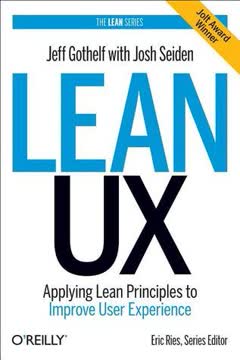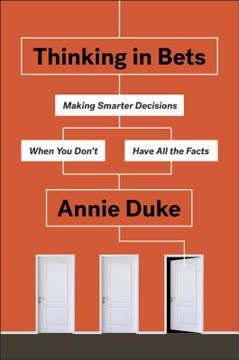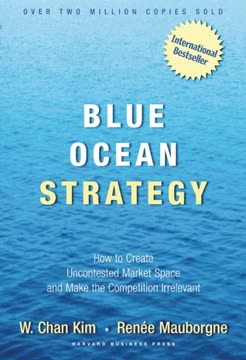Key Takeaways
1. Blue Ocean Strategy: Create uncontested market space
"Blue oceans are less about disruption and more about nondisruptive creation, where one's gain doesn't have to come at the expense of others."
Redefine competition. Blue Ocean Strategy challenges the conventional wisdom of competing in existing markets. Instead of fighting for market share in crowded "red oceans," companies should create new market space or "blue oceans" where competition is irrelevant.
Create new demand. By focusing on value innovation, companies can create and capture new demand. This approach expands the market rather than simply dividing up existing demand. Examples include:
- Cirque du Soleil: Reinvented the circus by combining elements of theater and acrobatics
- Yellow Tail: Created a new wine category by simplifying wine for non-wine drinkers
- Nintendo Wii: Appealed to non-gamers by focusing on simple, intuitive motion controls
Differentiate and lower costs. Blue Ocean Strategy allows companies to pursue differentiation and low cost simultaneously, breaking the value-cost trade-off traditionally seen as necessary in strategy.
2. Value Innovation: Break the value-cost trade-off
"Value innovation is the cornerstone of blue ocean strategy. We call it value innovation because instead of focusing on beating the competition, you focus on making the competition irrelevant by creating a leap in value for buyers and your company, thereby opening up new and uncontested market space."
Redefine value. Value innovation shifts the focus from competing within existing market boundaries to creating new value for customers. This involves looking beyond the current industry definition and identifying what buyers truly value.
Simultaneously pursue differentiation and low cost. Unlike traditional strategies that trade off between value and cost, value innovation seeks to:
- Eliminate factors the industry takes for granted
- Reduce factors well below industry standards
- Raise factors well above industry standards
- Create factors the industry has never offered
Examples of value innovation:
- Southwest Airlines: Low-cost model with high-frequency point-to-point routes
- Apple iPod/iTunes: Combined hardware, software, and content in a seamless ecosystem
- Salesforce.com: Delivered CRM software as a service, eliminating installation and maintenance costs
3. Six Paths Framework: Reconstruct market boundaries
"The first principle of blue ocean strategy is to reconstruct market boundaries to break from the competition and create blue oceans."
Expand your strategic thinking. The Six Paths Framework provides a systematic approach to challenging industry assumptions and creating new market space:
- Look across alternative industries
- Look across strategic groups within industries
- Look across the chain of buyers
- Look across complementary product and service offerings
- Look across functional or emotional appeal to buyers
- Look across time
Challenge industry assumptions. Each path challenges a fundamental assumption about how an industry operates, allowing companies to identify new opportunities:
- Alternative industries: Starbucks combined coffee shop and "third place" concepts
- Strategic groups: Toyota's Lexus bridged luxury and economy car segments
- Chain of buyers: Bloomberg targeted financial professionals, not just institutions
- Complementary offerings: Amazon expanded from books to a full e-commerce platform
- Functional/emotional appeal: Body Shop added ethical appeal to personal care products
- Time: Apple anticipated future needs with the iPhone and App Store ecosystem
4. Four Actions Framework: Eliminate-Reduce-Raise-Create
"The Four Actions Framework challenges a company to look across the factors that the industry competes on and ask four key questions to challenge an industry's strategic logic and business model."
Rethink your offering. The Four Actions Framework helps companies reconstruct buyer value elements across industry boundaries:
- Eliminate: Which factors should be eliminated?
- Reduce: Which factors should be reduced well below the industry's standard?
- Raise: Which factors should be raised well above the industry's standard?
- Create: Which factors should be created that the industry has never offered?
Apply the framework. Examples of how companies have used the Four Actions Framework:
-
Cirque du Soleil:
- Eliminated: Animal shows, star performers
- Reduced: Aisle concessions, thrills and danger
- Raised: Unique venue, artistic music and dance
- Created: Theme, refined environment
-
Yellow Tail:
- Eliminated: Enological terminology, aging qualities
- Reduced: Wine complexity, range
- Raised: Price versus budget wines, ease of selection
- Created: Fun and adventure, easy drinking
5. Three Tiers of Noncustomers: Expand your market
"To maximize the size of the blue ocean you're creating, you should first reach beyond existing demand to noncustomers and desegmentation opportunities as you're formulating future strategies."
Look beyond current customers. The Three Tiers of Noncustomers framework helps companies identify and tap into latent demand:
- First Tier: "Soon-to-be" noncustomers who are on the edge of your market
- Second Tier: "Refusing" noncustomers who consciously choose against your market
- Third Tier: "Unexplored" noncustomers who are in markets distant from yours
Expand your market. Examples of companies targeting noncustomers:
- JCDecaux: Targeted noncustomers of traditional advertising with street furniture
- Novo Nordisk: Reached diabetics in developing countries with low-cost insulin
- Canon: Appealed to individuals and small businesses with personal copiers
Identify commonalities. Look for overlapping needs and desires among noncustomers to create a larger, more sustainable blue ocean.
6. Visualize Strategy: Use strategy canvas and PMS map
"The strategy canvas is both a diagnostic and an action framework for building a compelling blue ocean strategy."
Create visual tools. The strategy canvas and pioneer-migrator-settler (PMS) map help companies visualize and communicate their strategy:
- Strategy Canvas: Graphically captures the current state of play in the known market space
- PMS Map: Plots a company's current and planned portfolio of businesses
Use the strategy canvas. Steps to create and analyze a strategy canvas:
- Plot the current industry factors of competition
- Chart competitors' strategic profiles and your own
- Identify areas where the industry focuses its investments
- Determine how to shift your strategic profile
Apply the PMS map. Categorize businesses as:
- Pioneers: Offer unprecedented value (blue oceans)
- Migrators: Offer improved value but not unprecedented (between red and blue)
- Settlers: Offer me-too value (red oceans)
7. Overcome Organizational Hurdles: Address the four hurdles
"To make a successful shift, you need to overcome the four key organizational hurdles that can prevent even the best strategies from being executed."
Identify and address hurdles. The four key organizational hurdles to strategy execution are:
- Cognitive: Wake employees up to the need for strategic change
- Resource: Secure critical resources needed to execute the new strategy
- Motivational: Motivate key players to move fast and tenaciously
- Political: Overcome opposition from powerful vested interests
Use tipping point leadership. Overcome these hurdles by:
- Focusing on influencers: Identify and leverage key influencers in the organization
- Mobilizing through "fishbowl" experiences: Create firsthand experiences that shift perspectives
- Distributing resources from hot spots to cold spots: Reallocate resources to areas of greatest need
- Silencing internal opponents: Address concerns and build coalitions
8. Build Execution into Strategy: Apply fair process
"Fair process is a key enabler to making people your allies, willing to go beyond the call of duty in executing blue ocean strategy."
Engage, explain, and set expectations. Fair process consists of three mutually reinforcing elements:
- Engagement: Involve individuals in decisions that affect them
- Explanation: Ensure everyone understands the rationale for decisions
- Expectation clarity: Clearly communicate new rules of the game
Foster trust and commitment. By applying fair process, organizations can:
- Build trust and commitment among employees
- Encourage voluntary cooperation
- Drive strategy execution from within
Examples of fair process:
- Nucor Steel: Engaged employees in strategy formulation and execution
- Tata: Explained rationale behind major decisions to all stakeholders
- Southwest Airlines: Set clear expectations for employee behavior and performance
9. Align Value, Profit, and People Propositions
"To create a sustainable blue ocean strategy, you need to align the three strategy propositions: the value proposition, the profit proposition, and the people proposition."
Ensure strategic fit. A successful blue ocean strategy must:
- Offer buyers exceptional value (value proposition)
- Generate healthy profits for the company (profit proposition)
- Motivate people to execute it (people proposition)
Create alignment. Steps to align the three propositions:
- Identify the key factors that create value for buyers
- Determine the cost implications of these factors
- Ensure the profit model supports the value and cost structure
- Engage and motivate employees to execute the strategy
Examples of aligned propositions:
- IKEA: Low-cost, stylish furniture (value) + efficient operations (profit) + empowered employees (people)
- Zappos: Exceptional customer service (value) + repeat purchases (profit) + strong company culture (people)
10. Renew Blue Oceans: Avoid red ocean traps
"To sustain blue oceans, companies need to monitor their value curves to see when it's time to value-innovate again."
Monitor and renew. Blue oceans can turn red over time due to imitation and changing market conditions. To sustain success:
- Continuously monitor your value curve
- Identify when the strategy needs renewal
- Avoid common "red ocean traps" that lead to competitive convergence
Red ocean traps to avoid:
- Treating market-creating strategies as customer-led
- Confusing technology innovation with market-creating strategies
- Viewing market creation as a marketing exercise
- Focusing on first-mover advantage instead of value innovation
Examples of blue ocean renewal:
- Apple: Shifted from personal computers to mobile devices and services
- Netflix: Transitioned from DVD rentals to streaming and original content
- Amazon: Expanded from online bookstore to e-commerce giant and cloud services provider
By continuously applying blue ocean principles and avoiding red ocean traps, companies can create and sustain uncontested market spaces, driving growth and profitability.
Last updated:
FAQ
What's Blue Ocean Shift about?
- Market Creation Focus: Blue Ocean Shift by W. Chan Kim and Renée Mauborgne emphasizes moving from competitive markets (red oceans) to untapped market spaces (blue oceans) where competition is irrelevant.
- Human-Centric Strategy: The book integrates the human element into strategy, highlighting the importance of confidence and creativity in successful market shifts.
- Systematic Process: It provides a five-step process for organizations to innovate and create new demand, using tools and frameworks to guide the transition.
Why should I read Blue Ocean Shift?
- Innovative Strategies: The book offers fresh perspectives on breaking free from traditional competitive strategies to create new market spaces.
- Proven Methodology: Based on nearly 30 years of research, it presents a tested framework successfully applied by various organizations worldwide.
- Real-World Examples: Filled with case studies from diverse industries, it provides practical insights and inspiration for readers.
What are the key takeaways of Blue Ocean Shift?
- Blue Ocean vs. Red Ocean: Understanding the distinction between competitive markets and new market spaces is crucial for growth without direct competition.
- Five-Step Process: The book outlines a systematic process for making a blue ocean shift, from getting started to making your move.
- Humanistic Approach: Emphasizes building confidence and creative competence among team members to foster a culture of innovation.
What is the five-step process to making a blue ocean shift?
- Step One: Get Started: Choose the right scope for the initiative and construct the right team to set the foundation.
- Step Two: Understand Current State: Assess the current industry landscape using tools like the strategy canvas.
- Step Three: Imagine New Possibilities: Uncover hidden pain points and identify noncustomers to think creatively about opportunities.
- Step Four: Find the Path: Reconstruct market boundaries and create new demand using the six paths framework.
- Step Five: Make Your Move: Select the blue ocean move, conduct rapid market tests, and launch the initiative.
What is the pioneer-migrator-settler map in Blue Ocean Shift?
- Portfolio Assessment Tool: It categorizes offerings into pioneers (value innovations), migrators (improved offerings), and settlers (imitative offerings).
- Strategic Vulnerability Insight: Helps identify strategically vulnerable areas and potential growth opportunities.
- Guides Decision-Making: Encourages critical thinking about current offerings and the need for change.
How does the strategy canvas work in Blue Ocean Shift?
- Visual Representation: Depicts an organization’s strategic profile in relation to competitors, showing key factors of competition.
- Identifies Competitive Dynamics: Highlights areas of convergence or divergence with competitors, aiding in understanding the industry landscape.
- Foundation for Change: Provides a baseline for assessing new ideas and strategies, highlighting the need for a blue ocean shift.
What is the buyer utility map in Blue Ocean Shift?
- Framework for Understanding Utility: Outlines the full range of buyer experiences, identifying pain points and opportunities for improvement.
- Six Stages of Experience: Breaks down the buyer experience into purchase, delivery, use, supplements, maintenance, and disposal.
- Utility Levers: Includes six utility levers to enhance buyer value, helping identify specific areas for innovation.
What is the eliminate-reduce-raise-create (ERRC) grid in Blue Ocean Shift?
- Strategic Framework: Categorizes factors into four actions: eliminate, reduce, raise, and create, to develop blue ocean strategies.
- Cost and Value Balance: Ensures the new offering is both affordable and compelling by balancing cost reduction with value creation.
- Visual Representation: Provides a clear visual of how the strategy diverges from existing industry practices.
How does Blue Ocean Shift define noncustomers?
- Three Tiers of Noncustomers: Categorizes noncustomers into first-tier (soon-to-be), second-tier (refusing), and third-tier (unexplored).
- Unlocking Demand: Identifying these tiers helps tailor offerings to meet new market needs and expand reach.
- Strategic Importance: Focusing on noncustomers allows for innovative solutions that attract new buyers.
What are the six paths framework in Blue Ocean Shift?
- Exploration of Opportunities: Guides organizations in exploring new market opportunities across alternative industries and strategic groups.
- Systematic Analysis: Provides structured ways to analyze the market and identify potential blue ocean opportunities.
- Actionable Insights: Generates insights leading to innovative strategies and offerings.
What is value innovation in Blue Ocean Shift?
- Core Concept: Focuses on creating new value for customers while simultaneously reducing costs.
- Differentiation and Low Cost: Challenges the traditional trade-off, allowing pursuit of both differentiation and low cost.
- Market Creation: By delivering exceptional value at a lower cost, companies can create new markets and make competition irrelevant.
What are some best quotes from Blue Ocean Shift and what do they mean?
- “It always seems impossible until it’s done.”: Emphasizes that success is achievable with the right mindset and approach.
- “Life can be much broader once you discover one simple fact.”: Encourages challenging existing norms and believing in the capacity to create change.
- “Noncustomers first.”: Highlights the importance of understanding and addressing noncustomers to unlock new demand.
Review Summary
Blue Ocean Shift receives mixed reviews, with many praising its practical approach to market creation and strategic innovation. Readers appreciate the detailed frameworks and case studies, finding them applicable to various industries. However, some criticize the book for being repetitive and overly long. The concept of moving from competitive "red oceans" to untapped "blue oceans" resonates with many, though some question its real-world effectiveness. Overall, it's seen as a valuable resource for businesses seeking new growth opportunities, despite its flaws.
Similar Books








Download PDF
Download EPUB
.epub digital book format is ideal for reading ebooks on phones, tablets, and e-readers.






